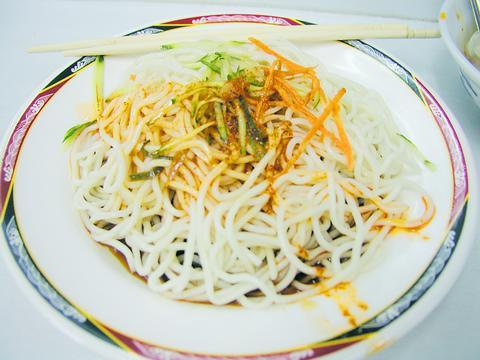Mention noodles and Ximending in the same sentence and most people will think of A-Chung Noodles (阿宗麵線), the tangy tripe noodle stall that often has a line of customers stretching half a block. That probably won't change soon, but there is another tiny eatery in Taipei's buzzing teeny bopper district called Qiong Fang Ju (瓊芳居) that specializes in noodles of a completely different variety and that draws its own throng of hungry fans to the basement of Wan-nian Department Store.
Little larger than a closet, Qiong Fang Ju is a stall operated by three jovial ladies who look as though they've been dipping liberally into their own tasty dishes when the crowds subside. And who can blame them? They're sitting on the secrets to two of the most delicious snacks available in Taipei.

PHOTO: MAX WOODWORTH, TAIPEI TIMES
Normally cold noodles are nothing to shout about, but Qiong Fang Ju has hit upon an especially delectable mix of vinegar, soy and subtle spices for its sauce, while adding color, texture and flavor with healthy portions of grated cucumber and carrots. On sweltering summer days made even less tolerable by shoulder-to-shoulder shopping masses in Ximending, a plate of these noodles is like a gift from the heavens.
Similarly, the dumplings are a delight for the senses, with a soy-and-vinegar sauce that is given some extra kick with additional spices and a fine pastry wrapping that is sturdy and perfectly chewy. The only complaint at the end of eating these tiny Sichuan delicacies will be that half a dozen just isn't enough. That's why many customers find themselves staring at empty dishes and committing for second helpings. Opting for seconds of the noodles and dumplings is probably a better choice than the cold chicken and duck dishes that fill up the rest of this mini-diner's menu.
Like many of the best snack stalls, Qiong Fang Ju places a low premium on decor and comfort. Diners will have to bear with throbbing fluorescent lights, wooden stools and the constant bumping of other diners buttocks into your back when they try to squeeze out of the joint. But it's a small price to pay.

The canonical shot of an East Asian city is a night skyline studded with towering apartment and office buildings, bright with neon and plastic signage, a landscape of energy and modernity. Another classic image is the same city seen from above, in which identical apartment towers march across the city, spilling out over nearby geography, like stylized soldiers colonizing new territory in a board game. Densely populated dynamic conurbations of money, technological innovation and convenience, it is hard to see the cities of East Asia as what they truly are: necropolises. Why is this? The East Asian development model, with

June 16 to June 22 The following flyer appeared on the streets of Hsinchu on June 12, 1895: “Taipei has already fallen to the Japanese barbarians, who have brought great misery to our land and people. We heard that the Japanese occupiers will tax our gardens, our houses, our bodies, and even our chickens, dogs, cows and pigs. They wear their hair wild, carve their teeth, tattoo their foreheads, wear strange clothes and speak a strange language. How can we be ruled by such people?” Posted by civilian militia leader Wu Tang-hsing (吳湯興), it was a call to arms to retake

Desperate dads meet in car parks to exchange packets; exhausted parents slip it into their kids’ drinks; families wait months for prescriptions buy it “off label.” But is it worth the risk? “The first time I gave him a gummy, I thought, ‘Oh my God, have I killed him?’ He just passed out in front of the TV. That never happens.” Jen remembers giving her son, David, six, melatonin to help him sleep. She got them from a friend, a pediatrician who gave them to her own child. “It was sort of hilarious. She had half a tub of gummies,

The wide-screen spectacle of Formula One gets a gleaming, rip-roaring workout in Joseph Kosinski’s F1, a fine-tuned machine of a movie that, in its most riveting racing scenes, approaches a kind of high-speed splendor. Kosinski, who last endeavored to put moviegoers in the seat of a fighter jet in Top Gun: Maverick, has moved to the open cockpits of Formula One with much the same affection, if not outright need, for speed. A lot of the same team is back. Jerry Bruckheimer produces. Ehren Kruger, a co-writer on Maverick, takes sole credit here. Hans Zimmer, a co-composer previously, supplies the thumping